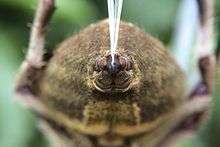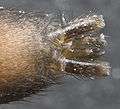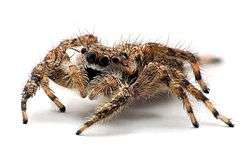Spinneret (spider)

A spinneret is a silk-spinning organ of a spider or the larva of an insect. Some adult insects also have spinnerets, such as those borne on the forelegs of Embioptera.[1] Spinnerets are usually on the underside of a spider's abdomen, to the rear.[2] While most spiders have six spinnerets, some have two, four, or eight.[3] They move independently and in concert.
Most spinnerets are not simple structures with a single orifice producing a single thread, but highly complex structures of many microscopic spigots, each producing one filament. This is important partly because it produces the necessary orientation of the protein molecules, without which the silk would be weak and useless. It also permits spiders to combine multiple filaments in different ways to produce many kinds of silk for special purposes.
Various species of spiders use silk extruded from spinnerets to build webs, to entrap insects by running round them, to make egg-cases, to catch the wind and fly (ballooning), etc. Some insect larvae (including silkworms) extrude silk to make a protective cocoon for their metamorphosis. The insects known as web spinners weave silken galleries for protection from predators and the elements while foraging and breeding.[4]
Observations suggesting that there might be silk-producing organs on the feet of the zebra tarantula (Aphonopelma seemanni) led to questions about the origins of spinnerets. It was hypothesised that spinnerets in spiders were originally used as climbing aids on the feet and evolved and were used for webmaking at a later time.[5] However, these observations have since been challenged, as described in the main article on tarantulas.
-
The compact spinnerets of Argiope bruennichi; placed ventrally below the posterior.
-

A barn spider encases her prey in silk emanating from her spinneret seen in the foreground.
-

Ventral aspect of spinnerets of spider species with unusually long spinnerets.
References
- ↑ INSECTA: EMBIOPTERA (EMBIIDINA), Retrieved December 1, 2013
- ↑ Wiggins, Charlotte (Nov 10, 2013). "Gardening to Distraction: Along came a spider". The Rolla Daily News. Therolladailynews.com. Retrieved December 1, 2013.
- ↑ Spider Identification – Types of Spiders, Retrieved December 1, 2013
- ↑ Richards, O. W.; Davies, R.G. (1977). Imms' General Textbook of Entomology: Volume 1: Structure, Physiology and Development Volume 2: Classification and Biology. Berlin: Springer. ISBN 0-412-61390-5.
- ↑ Gorb, SN; Niederegger S; Hayashi CY; Summers AP; Votsch W; Walther P (September 28, 2006). "Bio materials: silk-like secretion from tarantula feet". Nature. 443 (7110): 407. doi:10.1038/443407a. PMID 17006505.
